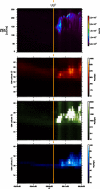Using ultra-low frequency waves and their characteristics to diagnose key physics of substorm onset
- PMID: 32215238
- PMCID: PMC7067274
- DOI: 10.1186/s40562-017-0089-0
Using ultra-low frequency waves and their characteristics to diagnose key physics of substorm onset
Abstract
Substorm onset is marked in the ionosphere by the sudden brightening of an existing auroral arc or the creation of a new auroral arc. Also present is the formation of auroral beads, proposed to play a key role in the detonation of the substorm, as well as the development of the large-scale substorm current wedge (SCW), invoked to carry the current diversion. Both these phenomena, auroral beads and the SCW, have been intimately related to ultra-low frequency (ULF) waves of specific frequencies as observed by ground-based magnetometers. We present a case study of the absolute and relative timing of Pi1 and Pi2 ULF wave bands with regard to a small substorm expansion phase onset. We find that there is both a location and frequency dependence for the onset of ULF waves. A clear epicentre is observed in specific wave frequencies concurrent with the brightening of the substorm onset arc and the presence of "auroral beads". At higher and lower wave frequencies, different epicentre patterns are revealed, which we conclude demonstrate different characteristics of the onset process; at higher frequencies, this epicentre may demonstrate phase mixing, and at intermediate and lower frequencies these epicentres are characteristic of auroral beads and cold plasma approximation of the "Tamao travel time" from near-earth neutral line reconnection and formation of the SCW.
© The Author(s) 2017.
Conflict of interest statement
The authors declare that they have no competing interests.
Figures





References
-
- Akasofu SI. The development of the auroral substorm. Planet Space Sci. 1964;12(4):273–282. doi: 10.1016/0032-0633(64)90151-5. - DOI
-
- Akasofu SI. Magnetospheric substorms. Q J R Astron Soc. 1977;18(2):170–187.
-
- Angelopoulos V. The THEMIS mission. Space Sci Rev. 2008;141:5–34. doi: 10.1007/s11214-008-9336-1. - DOI
-
- Arnoldy RL, et al. Simultaneous measurement of aurora-related, irregular magnetic pulsations at northern and southern high latitudes. J Geophys Res. 1987;92(A11):12221–12232. doi: 10.1029/JA092iA11p12221. - DOI
-
- Atkinson G. Current system of geomagnetic bays. J Geophys Res. 1967;72(23):6063–6067. doi: 10.1029/JZ072i023p06063. - DOI
LinkOut - more resources
Full Text Sources
Research Materials
Miscellaneous
